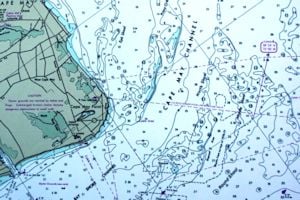THE FAMED CAPE MAY RIPS

Peril-ous adj. 1: involving peril or risk; dangerous 2: fishing the Cape May Rips
Throw in other descriptions such as treacherous, tumultuous and tempestuous, and you’ll get an idea of what it’s like to search for stripers in the notoriously dangerous and notoriously productive Cape May Rips.
Located off the southernmost tip of the peninsula county where the Delaware Bay and Atlantic Ocean meet in a calamitous collision of currents, “The Rips” are actually a series of shoals that extend from with a half-mile of the beach (the Eph Shoal) out to beyond the three mile federal water demarcation (the McCrie Shoal). Depths will range from approximately 30 feet to a very sudden four to even three feet, and when there is the wind against tide conditions that are common during the mid to late autumn period, the waves can easily approach eight to 10 feet. Coupled with the oftentimes confused, almost whirlpool-like currents, and it is understandable how quickly a boat can roll over or bottom up if attention to the surroundings is distracted even for a few seconds.
For safety’s sake, it is imperative that one always work the wheel while the companion(s) fish. Every year during the fall striper run especially, the Coast Guard has to perform rescues, and the towing company gets its share of business. Granted, it can be difficult to pay attention when the bite is on, the rods are bent and all hell is breaking loose. If you don’t have lazer-like focus here, someone near and dear may be cashing an insurance policy. It’s advised that first timers enlist the services of a local charter skipper once or twice to get a feel of the area before going it on one’s own.
%pullstart%"Success this time of the year is spelled e-e-l. A 12- to 15-inch slimer will be immediately inhaled by any bass in the vicinity."%pullend% The Rips’ late April through May striper slam is all about bouncing one to four ounce bucktails sweetened with strips of herring or mackerel. The autumnal bass blast commences in mid-October, intensifying through Thanksgiving and remains strong almost to the Yule. The linesiders won’t be as big as they are in the spring, but numbers make up for size, with fall fish ranging from schoolies up to 25 pounds, with some topping 30 not uncommon.
Success this time of the year is spelled e-e-l. A 12 to 15 inch slimer will be immediately inhaled by any bass in the vicinity. The basic rig consists of a one to three ounce egg sinker separated from the swivel by a bead to prevent wear on the knot. A 30 to 48 inch mono or fluorocarbon leader testing 30 to 50 pounds is attached to a short shank 4/0 or 5/0 live bait metal. Insofar as the main tether, some prefer a low stretch mono or copolymer in 25 or 30 pound test, others opt for braids with a 30, 40 or 50 test rating. Both incoming and outgoing tides generate action.
The Cape May Rips can be accessed via Cold Spring Inlet (a five mile ride) or the Cape May Canal. While bass can be caught throughout the expanse, the best spots are the Eph, Prissy Wicks, Somer, North, Gunmount, Round, Overfalls and Middle shoals.
Trolling plugs? Better in the spring but also productive in the fall. Think thrice, though, as there can be well over 100 boats drifting the area during prime times, adding to the Rips’ inherent physical confusion. You won’t make friends should you choose to pull hardware when traffic is heavy.